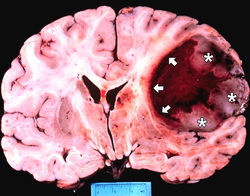|
|
Pathology definition - Glioblastoma Multiforme

Glioblastoma Multiforme
Glioblastoma multiforme is a primary neoplasm of the brain which carries a poor prognosis. Glioblastoma multiforme commonly present as non circumscribed lesion in the cerebral hemisphere. The treatment of glioblastoma multiforme may include surgical resection, chemotherapeutic approach and radiotherapy.
Glioblastoma multiforme may present with signs and symptoms such as nausea, vomiting, headaches, raised intracranial pressure due to the mass effect, cerebral edema and seizures.
Glioblastoma multiforme is also associated with high degree of anaplasia. Multiple tumor cells will be arranged in a pseudopalisading pattern with central areas of hemorrhage and necrosis. There is high degree os astrocytoma. Glioblastoma multiforme is associated with mutation of the tumor suppressor genes ( p53 and RB gene) which is common in a middle age population.
References
1.Burger, Peter C., and Sylvan B. Green. “Patient Age, Histologic Features, and Length of Survival in Patients with Glioblastoma Multiforme.” Cancer 59, no. 9 (1987): 1617–1625. doi:10.1002/1097-0142(19870501)59:9<1617::AID-CNCR2820590916>3.0.CO;2-X.
2.Burger, Peter C., and Robin T. Vollmer. “Histologic Factors of Prognostic Significance in the Glioblastoma Multiforme.” Cancer 46, no. 5 (1980): 1179–1186. doi:10.1002/1097-0142(19800901)46:5<1179::AID-CNCR2820460517>3.0.CO;2-0.
Glioblastoma multiforme is a primary neoplasm of the brain which carries a poor prognosis. Glioblastoma multiforme commonly present as non circumscribed lesion in the cerebral hemisphere. The treatment of glioblastoma multiforme may include surgical resection, chemotherapeutic approach and radiotherapy.
Glioblastoma multiforme may present with signs and symptoms such as nausea, vomiting, headaches, raised intracranial pressure due to the mass effect, cerebral edema and seizures.
Glioblastoma multiforme is also associated with high degree of anaplasia. Multiple tumor cells will be arranged in a pseudopalisading pattern with central areas of hemorrhage and necrosis. There is high degree os astrocytoma. Glioblastoma multiforme is associated with mutation of the tumor suppressor genes ( p53 and RB gene) which is common in a middle age population.
References
1.Burger, Peter C., and Sylvan B. Green. “Patient Age, Histologic Features, and Length of Survival in Patients with Glioblastoma Multiforme.” Cancer 59, no. 9 (1987): 1617–1625. doi:10.1002/1097-0142(19870501)59:9<1617::AID-CNCR2820590916>3.0.CO;2-X.
2.Burger, Peter C., and Robin T. Vollmer. “Histologic Factors of Prognostic Significance in the Glioblastoma Multiforme.” Cancer 46, no. 5 (1980): 1179–1186. doi:10.1002/1097-0142(19800901)46:5<1179::AID-CNCR2820460517>3.0.CO;2-0.
